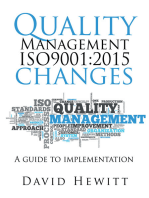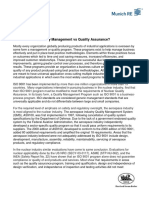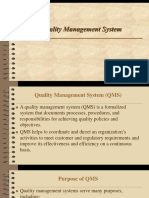ISO 9001 Process
Uploaded by
leebowler331ISO 9001 Process
Uploaded by
leebowler331ISO 9001 process
Introduction
One of the requirements of ISO 9001:2000, specified in the paragraph 4.2.2 c),
requires a company to develop a quality manual that, among other attributes, shall
contain "a description of the interaction between the processes of the quality
management system." Through my experience, as a professional auditor, with dozens
of companies around the world, I found that very few businesses had developed
practical approaches to address this requirement. Attempts to document process
interactions range from busy and hard to read flow charts to establishing cross-
reference tables in the quality manual. I observed one of the best tools to address
process interaction requirement at Quality Works, a small on-line publishing
company.
Initiation of the project
Quality Works, a small Internet-based publishing company, has set a goal to establish
compliance with ISO 9001:2000 standard. The Management Team assigned the
company's Business Manager to develop and implement documentation to address
new requirements of the standard. While most of the new requirements were simply
addressed through preparation of the corresponding procedures and work instructions,
documentation of the interaction of the processes created some difficulties. Attempts
to document interaction of processes through traditional flow-chart resulted in a hard
to read busy document that did not impress the management team.
Brainstorming
To address this issue, the management group conducted a brainstorming session to
search for a new tool. The group determined that there were two types of the
processes: processes related to product realization and processes related to the
management system as follows:
Business management processes:
- Documentation management
- Management review
- Internal audit program
- Non-conformity and Corrective & Preventive Action (NC-CAPA) System
- Communication
- Resource management
- Record management
- Information technology
Product realization processes:
- Market analysis
- Product design
- Verification
- Validation
- Product release
- Order processing
- Product delivery
- Customer satisfaction
- Continual improvement
Identification of process interactions
Analyzing system and product realization processes, the management team concluded
that virtually all system processes are interrelated. For example, management review
may receive inputs from corrective actions, communication, internal audits, etc.
Internal audit process receives inputs from all processes within the company and
provides feedback or input into all those processes.
Product realization process was found to be more linear than system processes. For
example, results of the market analysis initiate product design. Product design leads to
verification. If verification is successful, validation of the product takes place.
Validation of the product results in product release and finally communication
regarding availability of the product. Customer satisfaction and continual
improvement close this sequence with a possibility of providing inputs into Product
delivery, Order processing, Product release, etc.
To document process interactions, the company elected two tools. The first, top-level
definition of the process interaction was documented in the Process Interaction Matrix
shown in Figure 1 (see links below). The second tool was a well-known technique of
flow-charting for those processes that required graphical illustration.
Afterword
Use of the Process Interaction Matrix at Quality Works proved that it is a helpful
concise method of defining and documenting interaction of processes for an ISO
9001:2000 quality management system. Based on our experience, we also realized
that the same matrix might be successfully used for other standards requiring
definition of the interaction of the processes, such as ISO 13485:2003, ISO/TS 16949
[3] and others.
Acknowledgments
The author would like to express his gratitude to Maria Allen, the President of Quality
Works, for her willingness to conduct and publish this case study.
References
[1] ISO 9001:2000 Quality management systems - Requirements
[2] ISO 13485:2003 Medical devises - Quality management systems - Requirements
for regulatory purposes
[3] ISO/TS 16949 Quality management systems - particular requirements for the
application of ISO 9001:2000 for automotive production and relevant service part
organizations.
You might also like
- Discover ISO 9001:2015 Through Practical Examples: A Straightforward Way to Adapt a QMS to Your Own BusinessFrom EverandDiscover ISO 9001:2015 Through Practical Examples: A Straightforward Way to Adapt a QMS to Your Own Business4.5/5 (22)
- Iso 9001 Audit Trail: A Practical Guide to Process Auditing Following an Audit TrailFrom EverandIso 9001 Audit Trail: A Practical Guide to Process Auditing Following an Audit Trail5/5 (3)
- QMS Training Guide Prep. Based On.... Clause 6 HAM. 19.15ECNo ratings yetQMS Training Guide Prep. Based On.... Clause 6 HAM. 19.15EC17 pages
- Quality Management Vs Quality Assurance June 20170% (1)Quality Management Vs Quality Assurance June 20172 pages
- Awareness and Use of ISO 9000:2015 "Quality Management: Systems - Fundamentals and Vocabulary"No ratings yetAwareness and Use of ISO 9000:2015 "Quality Management: Systems - Fundamentals and Vocabulary"19 pages
- Iso 9001 2015 Quality Objectives and Definitions83% (12)Iso 9001 2015 Quality Objectives and Definitions20 pages
- BSI ISO 9001 Self Assessment Checklist PDFNo ratings yetBSI ISO 9001 Self Assessment Checklist PDF2 pages
- ISO 9001 2015 Interpretation Guidance SampleNo ratings yetISO 9001 2015 Interpretation Guidance Sample9 pages
- Gd-04 Steps To Management System Certification - Kebs CB Rev 4 - 23 JanNo ratings yetGd-04 Steps To Management System Certification - Kebs CB Rev 4 - 23 Jan4 pages
- Iso 9000 and Total Quality: The Relationship: Introduction To Quality Management Tell 26100% (1)Iso 9000 and Total Quality: The Relationship: Introduction To Quality Management Tell 2625 pages
- Compariosn Between IATF and TS RequirementsNo ratings yetCompariosn Between IATF and TS Requirements32 pages
- Financial Customer / Client Internal Processes Learning and GrowthNo ratings yetFinancial Customer / Client Internal Processes Learning and Growth1 page
- ISO 9001:2015 ISO 13485:2015: 4 Context of The Organization 4 Quality Management SystemNo ratings yetISO 9001:2015 ISO 13485:2015: 4 Context of The Organization 4 Quality Management System3 pages
- Summary of New QMS Documents With References To ISO 9001 & IATF 16949 Clauses100% (2)Summary of New QMS Documents With References To ISO 9001 & IATF 16949 Clauses8 pages
- Complete The Sentences With The Correct Form of The Words in Capitals!No ratings yetComplete The Sentences With The Correct Form of The Words in Capitals!4 pages
- Criterion Referenced Assessment Workshop Handout 20111502No ratings yetCriterion Referenced Assessment Workshop Handout 201115027 pages
- 4 Th. Stage Methods of Construction and Estimation (Yousif Salam Shwani)No ratings yet4 Th. Stage Methods of Construction and Estimation (Yousif Salam Shwani)124 pages
- Upper Assam Road Trip Visiting Namsai ArunachalNo ratings yetUpper Assam Road Trip Visiting Namsai Arunachal1 page
- Albina Omarova: Industrial Product DesignerNo ratings yetAlbina Omarova: Industrial Product Designer54 pages
- (Ebooks PDF) Download (Ebook PDF) Understanding Patent Law, Third Edition 3rd Edition Full Chapters100% (3)(Ebooks PDF) Download (Ebook PDF) Understanding Patent Law, Third Edition 3rd Edition Full Chapters51 pages
- Dynamic - Characterstics of Instruments Aug 2023No ratings yetDynamic - Characterstics of Instruments Aug 202396 pages
- Why Do Local Governments Return Money To The Treasury?No ratings yetWhy Do Local Governments Return Money To The Treasury?1 page
- Integration of Git Java and Maven To JenkinsNo ratings yetIntegration of Git Java and Maven To Jenkins2 pages
- Quay Et Al (2022) Dewey's Education Through Occupations As Being-Doing-Knowing Creative Learning UnitsNo ratings yetQuay Et Al (2022) Dewey's Education Through Occupations As Being-Doing-Knowing Creative Learning Units17 pages
- Manual de Utilizare Masina de Spalat IndesitNo ratings yetManual de Utilizare Masina de Spalat Indesit84 pages
- Persepsi Dan Motivasi Mahasiswa Dalam Memilih Program Studi Pada Jurusan Pendidikan Bahasa Dan SeniNo ratings yetPersepsi Dan Motivasi Mahasiswa Dalam Memilih Program Studi Pada Jurusan Pendidikan Bahasa Dan Seni11 pages

























































































